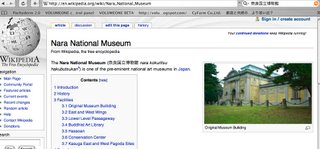Background
A friend of mine, Ritsuko Segawa, who is a well established independent scriptwriter and a producer of programs for museum audio tours once told me about her personal experience as following. She was contacted by a certain gentleman whose elderly Mother had been in a hospital with a terminal illness. This gentleman, with an assistance of museum's public information office, phoned Ritsuko and asked her a permission to borrow her audio tour equipment personally and take it outside the museum so that his Mother could hear the program in her hospital bed.
At first, Ritsuko was hesitant about this request. As being a professional in museum education, providing content for audio tour at various museums for many years, she was afraid that the program might not be understood correctly without actually seeing the exhibition itself. But then, this gentleman explained that his Mother knows the floor plan of this particular museum and the subject of the exhibition really well.
 This story took place at the Nara National Museum a couple of years ago during the time of annual exhibit of treasures of "Shoso-in" which is the most popular subject at this museum. The Shoso-in is an ancient repository of imperial treasures near the Todai-ji Temple in Nara-City and the National Museum there has been organizing the exhibitions to show these treasures with different themes annually every fall-winter season for nealy 60 years. The Mother of this gentleman too had been going to see these exhibitions every year without missing up until the previous year. Touched by this gentleman's thought for his Mother, Ritsuko decided to take a chance and let him take the audio tour equipment to the hospital.
This story took place at the Nara National Museum a couple of years ago during the time of annual exhibit of treasures of "Shoso-in" which is the most popular subject at this museum. The Shoso-in is an ancient repository of imperial treasures near the Todai-ji Temple in Nara-City and the National Museum there has been organizing the exhibitions to show these treasures with different themes annually every fall-winter season for nealy 60 years. The Mother of this gentleman too had been going to see these exhibitions every year without missing up until the previous year. Touched by this gentleman's thought for his Mother, Ritsuko decided to take a chance and let him take the audio tour equipment to the hospital. Upon returning the equipment, the gentleman told Ritsuko how his Mother enjoyed listening to the program, especially with the help of her son's personal comment on how the exhibition is laid out this year. The Mother and the son talked also about their experience together in past exhibitions at the museum and obviously it was a valuable moment for both of them to share.
This story was quite inspiring and I couldn't help starting to explore the possibilities by talking to colleagues what we could possibly do as educational institution to step in between museums and the people with restricted mobility. When I say "people with restricted mobility", I mean any patients in the hospital, particularly young children with problems with their immune system who are not allowed to contact the world outside hospital, and elderly people, or any adult anywhere with inability to drive, or taking public transportation by themselves.
My idea was to deliver museum content in a lively form for those who cannot physically come to the museum. I was determined to do something more than just putting up static pictures of the museum buildings, galleries and collections on the web, or letting the people outside to use the audio tour equipment without any images. We had to find something to bridge between these two.

0 Comments:
Post a Comment
<< Home